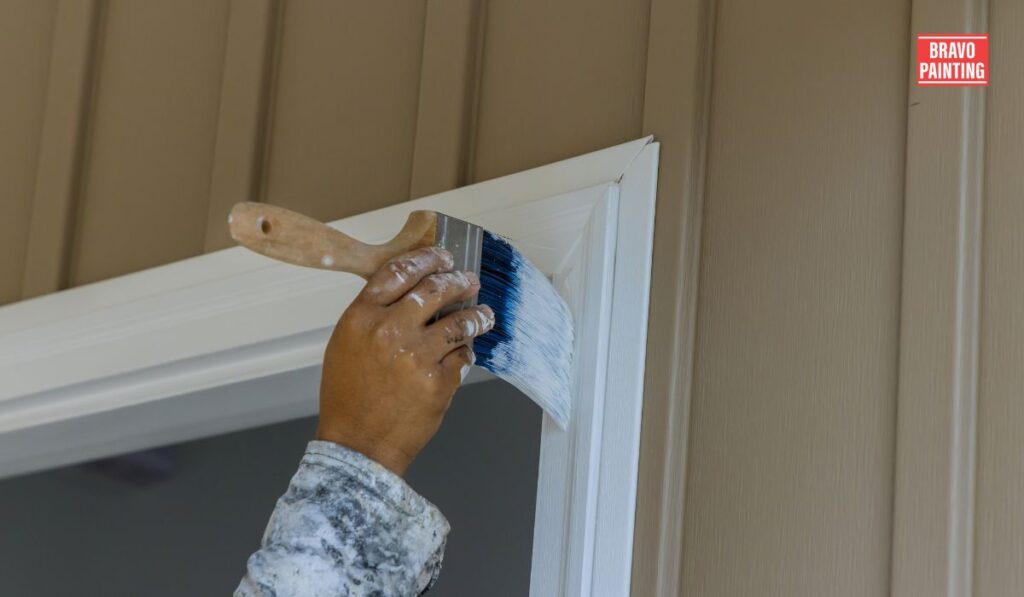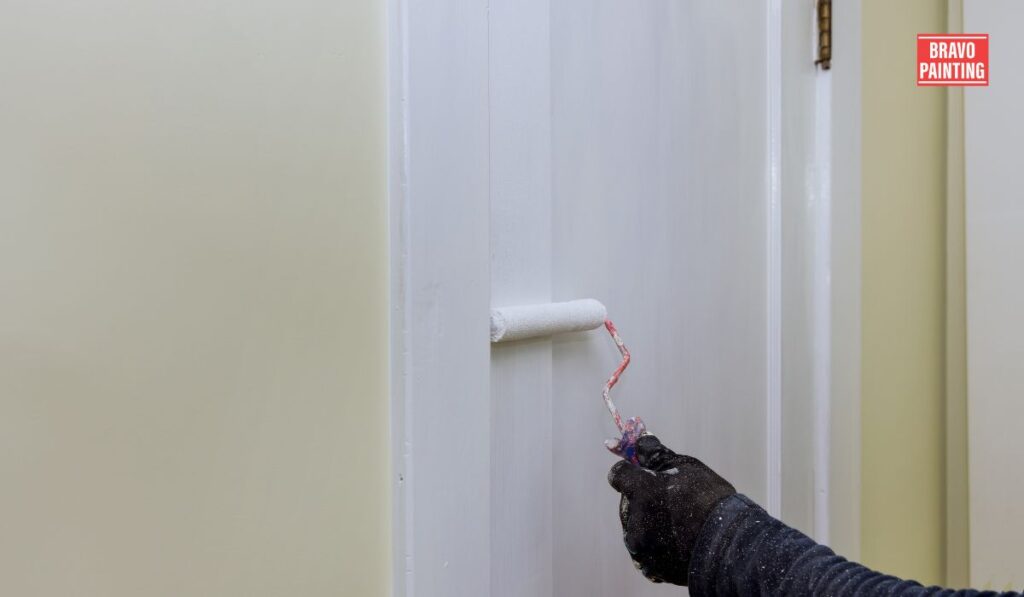When it comes to interior design, the colors you choose for your doors and trim can have a profound impact on the overall look and feel of your home.
Whether you aim for a modern, classic, or eclectic style, selecting the right colors for your interior doors and trim is crucial.
This guide will help you navigate the options and make an informed decision.
Understanding the Basics
Before diving into color choices, it’s essential to understand the role of doors and trim in your interior design:
- Interior Doors are functional elements that contribute to the visual flow of your rooms. They can be a focal point or blend seamlessly into the background.
- Trim: This includes baseboards, crown molding, and door and window casings. Trim provides definition and structure to a space.
Classic White and Neutral Tones
White:
- Timeless Appeal: White trim and doors have been a staple in interior design for decades. They offer a clean, crisp look that works with almost any wall color.
- Versatility: White can complement both traditional and modern aesthetics. It provides a neutral canvas that allows other design elements to stand out.
- Shades of White: There are various shades of white, from stark, bright whites to warmer, creamy tones. The choice depends on the lighting and the desired ambiance.

Neutrals (Gray, Beige, and Taupe):
- Subtle Sophistication: Neutrals like gray, beige, and taupe offer a sophisticated, understated elegance. They are less stark than white but still versatile.
- Modern and Cozy: These colors can create a contemporary look without feeling cold. Warm grays and beiges add coziness to a room.
- Harmonizing Elements: Neutral tones can harmonize with a wide range of wall colors and furnishings, making them a safe and stylish choice.
Bold and Dramatic Colors
Black:
- Striking Contrast: Black trim and doors make a bold statement and can create a dramatic contrast against lighter walls. This works well in modern and industrial designs.
- Elegance and Sophistication: Black exudes elegance and sophistication. It can make a room feel more intimate and grounded.
- Maintenance: Black can show dust and scratches more quickly, so it requires regular maintenance to keep it looking pristine.
Dark Colors (Navy, Charcoal, Deep Green):
- Depth and Warmth: Dark colors add depth and warmth to a space. They can create a cozy, intimate atmosphere.
- Stylish and Contemporary: These colors are popular in contemporary design for their chic appeal.
- Accent and Focal Points: Dark doors and trim can act as accent pieces, drawing attention to architectural details and adding visual interest.
Matching vs. Contrasting
Matching Colors:
- Cohesive Look: Matching the color of your doors and trim with the wall color creates a seamless, cohesive look, which can make a space feel larger and more open.
- Subtle Elegance: Matching colors can be subtle and elegant, allowing furniture and decor to take center stage.
Contrasting Colors:
- Visual Interest: Using contrasting colors for doors and trim adds visual interest and highlights architectural features.
- Dynamic Design: Contrast can create a dynamic, energetic vibe in a room. It can also be used to delineate different areas in an open-plan space.
Consider the Room’s Purpose
- Living Areas: Consider warm, inviting colors for living rooms and family rooms, which encourage relaxation and socializing.
- Bedrooms: Soft, calming colors work well in bedrooms to create a serene environment. Dark colors can also make a cozy, cocoon-like feel.
- Kitchens and Bathrooms: These spaces often benefit from bright, clean colors. White or light neutrals can make these rooms feel fresh and airy.
Considering Architectural Style
The architectural style of your home can significantly influence your choice of door and trim colors. Here’s how different styles can guide your decision:
Traditional Homes:
- Classic Whites and Creams: Traditional homes often feature intricate moldings and detailed trim work, which whites and creams beautifully highlight.
- Rich Woods: Consider staining doors and trim in rich wood tones like mahogany or walnut to complement the classic aesthetic.
Modern and Contemporary Homes:
- Bold Contrasts: Modern homes can handle more daring contrasts.
Black or charcoal gray trim against white or light-colored walls creates a striking look.
- Minimalist Neutrals: Soft grays and muted tones offer a sleek, minimalist appeal.
They provide a backdrop that allows modern furnishings and artwork to shine.
Cottage and Farmhouse Styles:
- Soft Pastels and Whites: Soft pastels, whites, and light grays create a cozy, inviting atmosphere typical of cottage and farmhouse styles.
- Natural Wood: Exposed, natural wood trim and doors can enhance the rustic charm. Consider lighter wood stains to keep the look fresh and airy.
Mid-Century Modern:
- Retro Colors: For doors, embrace retro-inspired colors like mustard yellow, teal, or burnt orange. Pair with neutral trim to balance the vibrancy.
- Clean Lines: Simple, clean lines in neutral tones for trim work well to maintain the mid-century modern aesthetic.
Coordinating with Wall Colors and Furniture
Your choice of door and trim colors should also coordinate with your wall colors and furniture. Here are some tips:
Complementary Colors:
- Harmony: To create a harmonious look, choose opposite colors on the color wheel.
For example, if your walls are a soft blue, consider warm beige or creamy white for trim.
- Accent Doors: Use complementary colors to make doors stand out as accent pieces.
A teal door against a peach wall creates a striking focal point.
Monochromatic Schemes:
- Subtle Elegance: Using varying shades of the same color can create a nuanced, sophisticated look. Light gray walls with darker gray trim and doors offer a cohesive feel.
- Depth: Monochromatic schemes add depth without overwhelming the space. This works particularly well in small rooms.
Matching Undertones:

- Consistency: Ensure that the undertones of your trim and door colors match those of your walls and furniture. For example, if your walls have warm undertones, choose warm-toned trim and door colors to maintain consistency.
The Impact of Light
Light plays a crucial role in how colors appear in your home.
Natural and artificial lighting can change the perception of color throughout the day.
Here’s how to take lighting into account:
Natural Light:
- Bright Spaces: Rooms with abundant natural light can handle darker trim and door colors without feeling closed in. Dark colors can add depth and sophistication.
- Light Reflectance: Light colors reflect more natural light, making small or dimly lit spaces feel larger and brighter.
Artificial Light:
- Warm Lighting: Warm light bulbs can enhance the warmth of neutral or dark colors, creating a cozy atmosphere.
- Excellent Lighting: Cool light bulbs can make colors appear more vibrant and authentic to their hue, which is ideal for modern and contemporary designs.
Conclusion
Choosing the right color for your interior doors and trim is a critical component of creating a cohesive and inviting home.
By considering factors like architectural style, wall colors, lighting, and personal preferences, you can make an informed decision that enhances the beauty and functionality of your space.
Whether you opt for classic whites, sophisticated neutrals, bold contrasts, or personalized hues, the right colors can transform your home into a reflection of your unique style and taste.
Ready to transform your interior with a fresh coat of paint?
Contact Bravo Painting for expert painting services and professional advice on color selection.
FAQs
Why is the color of interior doors and trim necessary in interior design?
The color of doors and trim can significantly impact the overall look and feel of your home’s interior design, contributing to its style, ambiance, and visual appeal.
What are the basics to understand before choosing colors for interior doors and trim?
Before selecting colors, it’s crucial to understand the role of doors and trim. These elements provide both functional and aesthetic elements to your space. Doors can serve as focal points or blend into the background, while trim offers definition and structure.
What are some classic color choices for interior doors and trim?
Classic options include white and neutral tones like gray, beige, and taupe. White offers timeless appeal and versatility, while neutrals provide subtle sophistication and harmonize with various design styles and furnishings.
How do bold and dramatic colors like black or dark tones impact interior design?
Bold colors such as black or dark navy, charcoal, or deep green can create striking contrasts, add depth and warmth to a space, and act as accent pieces or focal points, enhancing visual interest and architectural details.
Should interior door and trim colors match or contrast with each other?
Matching colors can create a cohesive and elegant look, making a space feel larger and more open. Contrasting colors add visual interest and dynamic energy and can delineate different areas within a room.
How should color choices for interior doors and trim be influenced by the room’s purpose?
Consider warm, inviting colors for living areas, soft, calming hues for bedrooms, and bright, clean colors for kitchens and bathrooms, aligning with the intended atmosphere and functionality of each space.
How does the architectural style of a home influence door and trim color choices?
The architectural style can guide color decisions, with traditional homes often featuring classic whites and creams, modern homes embracing bold contrasts or minimalist neutrals, cottage/farmhouse styles favoring soft pastels or natural wood, and mid-century modern designs incorporating retro or monochromatic schemes.
How should door and trim colors coordinate with wall colors and furniture?
Choose complementary colors for harmony, consider accent doors for focal points, opt for monochromatic schemes for subtle elegance and depth, and ensure consistency in undertones to maintain cohesion with wall colors and furniture.
What role does lighting play in the perception of door and trim colors?
Lighting, both natural and artificial, can alter how colors appear throughout the day. Natural light affects brightness and light reflectance, while artificial light can enhance warmth or vibrancy, influencing the overall ambiance of a space.



